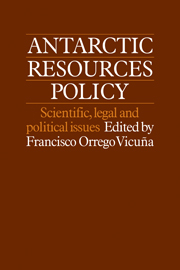Book contents
- Frontmatter
- Contents
- List of contributors
- 1 Antarctic resources policy: an introduction
- Part one The state of Antarctic knowledge and experience
- Part two The policy for the conservation of the living resources of Antarctica
- Part three The policy for the exploration and exploitation of the mineral resources of Antarctica
- 11 Geologic data and its impact on the discussion on a regime for mineral resources
- 12 Basic conditions for the exploration and exploitation of mineral resources in Antarctica: options and precedents
- 13 Oil as a special resource: problems and experiences
- 14 An overview of the problems which should be addressed in the preparation of a regime governing the mineral resources of Antarctica
- 15 The definition of a regime on Antarctic mineral resources: basic options
- 16 Criteria for access to the resources of Antarctica: alternatives, procedure and experience applicable
- Part four Issues on Antarctica and the law of the sea
- Part five The policy for Antarctic cooperation
12 - Basic conditions for the exploration and exploitation of mineral resources in Antarctica: options and precedents
Published online by Cambridge University Press: 06 July 2010
- Frontmatter
- Contents
- List of contributors
- 1 Antarctic resources policy: an introduction
- Part one The state of Antarctic knowledge and experience
- Part two The policy for the conservation of the living resources of Antarctica
- Part three The policy for the exploration and exploitation of the mineral resources of Antarctica
- 11 Geologic data and its impact on the discussion on a regime for mineral resources
- 12 Basic conditions for the exploration and exploitation of mineral resources in Antarctica: options and precedents
- 13 Oil as a special resource: problems and experiences
- 14 An overview of the problems which should be addressed in the preparation of a regime governing the mineral resources of Antarctica
- 15 The definition of a regime on Antarctic mineral resources: basic options
- 16 Criteria for access to the resources of Antarctica: alternatives, procedure and experience applicable
- Part four Issues on Antarctica and the law of the sea
- Part five The policy for Antarctic cooperation
Summary
Introduction
This paper deals with hydrocarbon prospectivity in the Antarctic, available technology and the accomplishment of the three successive stages commencing with exploration and ending in exploitation. Furthermore, geological and technical questions related to allocation of licences, work programmes, requirements and regulations in alternative regimes are also discussed. A section on minerals other than hydrocarbons is also included.
Political questions related to the jurisdiction of the area are beyond the scope of this paper. It is, however, not always easy to make a clear distinction between political and geological/technical questions since they are interdependent.
The base map used in the succeeding figures and the territorial claims are shown in Fig. 12.1.
It should be stressed that no specific time is implied regarding the start of the commercial exploration. I do, however, assume that once the political decision to open areas has been made, the intention is to have regimes which allow efficient operations.
Finally it should be stressed that all views expressed in this paper are my own personal views.
Prospectivity – minerals other than hydrocarbons
Minerals have been known to exist in the Antarctic for many decades. Coal was one of the first minerals to be discovered. It was burned as fuel as early as 1907–09.
The thick ice coverage is a major obstacle for the onshore exploration for minerals. Only some 140,000 km2 (54,000 miles2) of land is without permanent ice coverage – barely 1% of the Antarctic continent. (See Fig. 12.2.)
- Type
- Chapter
- Information
- Antarctic Resources PolicyScientific, Legal and Political Issues, pp. 167 - 184Publisher: Cambridge University PressPrint publication year: 1983
- 1
- Cited by



